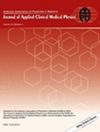Commissioning and clinical implementation of low dose dual-field rotational TSET
Abstract
Background
Total skin electron therapy (TSET) is a specialized technique for treating cutaneous T-cell lymphomas, such as mycosis fungoides. While traditional TSET regimens prescribe 30–36 Gy, low dose TSET at 12 Gy has gained attention due to its reduced toxicity. The dual-field rotational TSET technique, utilizing a standard linac, offers a practical solution for improved dose distribution. However, limited studies exist on its commissioning and clinical implementation.
Purpose
This study aimed to commission and clinically implement a low dose dual-field rotational TSET technique. The primary objectives were to optimize beam geometry, characterize dosimetry, and ensure treatment uniformity while maintaining compliance with ACPSEM, EORTC, and AAPM guidance.
Methods
A Varian TrueBeam linac equipped with a 6 MeV high-dose-rate total skin electron beam was commissioned for TSET. Dosimetric measurements included beam output calibration, relative dosimetry, and dose uniformity assessment using an ion chamber and Gafchromic film, with verification using an anthropomorphic phantom. A treatment dose calculation methodology was developed. Shielding, ozone generation, and quality assurance were assessed. In vivo dosimetry was performed for treatment validation.
Results
The optimal dual-field beam geometry was determined to be ± 18° from the horizontal, achieving vertical uniformity within ± 2.9% and an overall treatment plane uniformity of ± 8.6%. Under rotation, the depth dose is delivered 100% at the surface, with bremsstrahlung contamination of 0.2 Gy. Custom eye shielding was developed, and ozone concentrations remained below the NCRP 0.1 parts per million (ppm) safety thresholds. In vivo dosimetry confirmed treatment uniformity within EORTC guidelines and identified three regions requiring dose boosts: the shoulders, palms, and inner thighs.
Conclusions
The commissioned dual-field rotational TSET technique provides a viable treatment option, achieving clinically acceptable dose distribution.


 求助内容:
求助内容: 应助结果提醒方式:
应助结果提醒方式:


